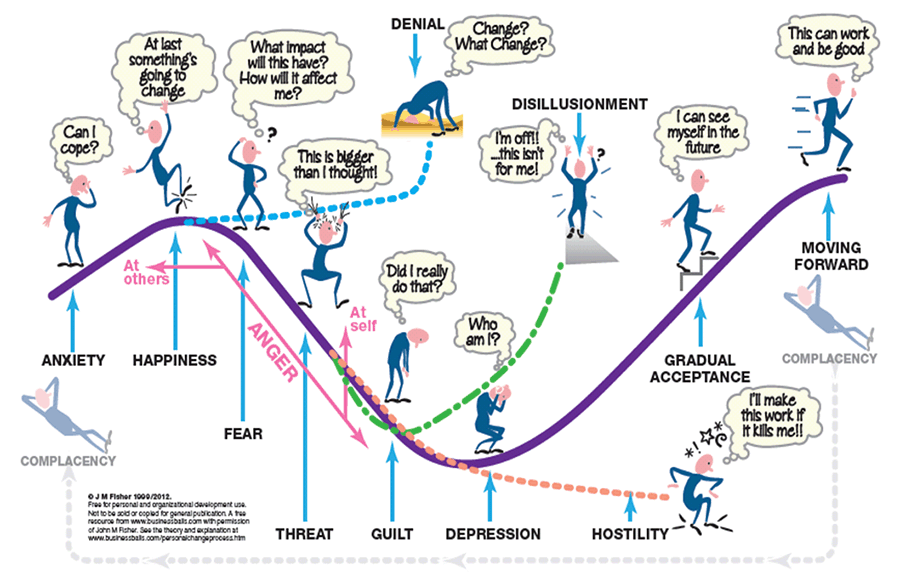The Process of Transition
Introduction
Here’s some information about how, as individuals we move through a change process! This process puts the “I” into change. most change models operate at an organisational level and almost always ignore the individual apart from as a cog in a bigger process. This model reverses that trend and puts the person firmly at the heart of any change.
This model first, formally, saw the light of day in: Fisher J M, 2000, Creating the Future?, in Scheer J W (ed), The Person in Society: Challenges to a Constructivist Theory, Geissen, Psychosozial-Verlag, ISBN 3898060152 and was in a paper I gave at the 1999 International Congress on Personal Construct Psychology held in Berlin (a lovely place).
Progressing through the Transition Curve
It can be seen from the transition curve that it is important for an individual to understand the impact that the change will have on their own personal construct systems; and for them to be able to work through the implications for their self perception. Any change, no matter how small, has the potential to impact on an individual and may generate conflict between existing values and beliefs and anticipated altered ones.
One danger for the individual, team and organisation occurs when an individual persists in operating a set of practices that have been consistently shown to fail (or result in an undesirable consequence) in the past and that do not help extend and elaborate their world-view. Another danger area is that of denial where people maintain operating as they always have denying that there is any change at all. Both of these can have detrimental impact on an organisation trying to change the culture and focus of its people.
To help people move through the transition effectively we need to understand their perception of the past, present and future. What is their past experience of change and how has it impacted on them?, how did they cope? Also what will they be losing as part of the change and what will they be gaining?
Process of Transition:
Swedish Language Version
Spanish Language Version
German Language Version
This content is Copyrighted. However if you wish to use them for your own private (i.e. non commercial) use then feel free to do so. However if you are using them as part of a package that is being sold (either as a training course, within a behavioural change programme, etc.) then please contact John Fisher for permission.
FAQ
“I really like how John’s transition curve illustrates the range of emotions/reactions that can occur when someone is working through change, as well as the timeline being unique depending on the person and the change involved … I think it is helpful in terms of stopping to reflect [on] not only where you are with a change, but where others are as well in order to attune to what they are experiencing and to help as possible.”
Process of Transition Questions
I’d like to thank Alan Chapman of www.businessballs.com for his support of the model in hosting it on his website for, what is now, well over a decade. Alan is also responsible for the image of the curve shown above – again thanks Alan.
Thanks to Jörn Scheer for the German translation of the Process of Transition.
This content is Copyrighted. However if you wish to use them for your own private (i.e. non commercial) use then feel free to do so. However if you are using them as part of a package that is being sold (either as a training course, within a behavioural change programme, etc.) then please contact John Fisher for permission.

